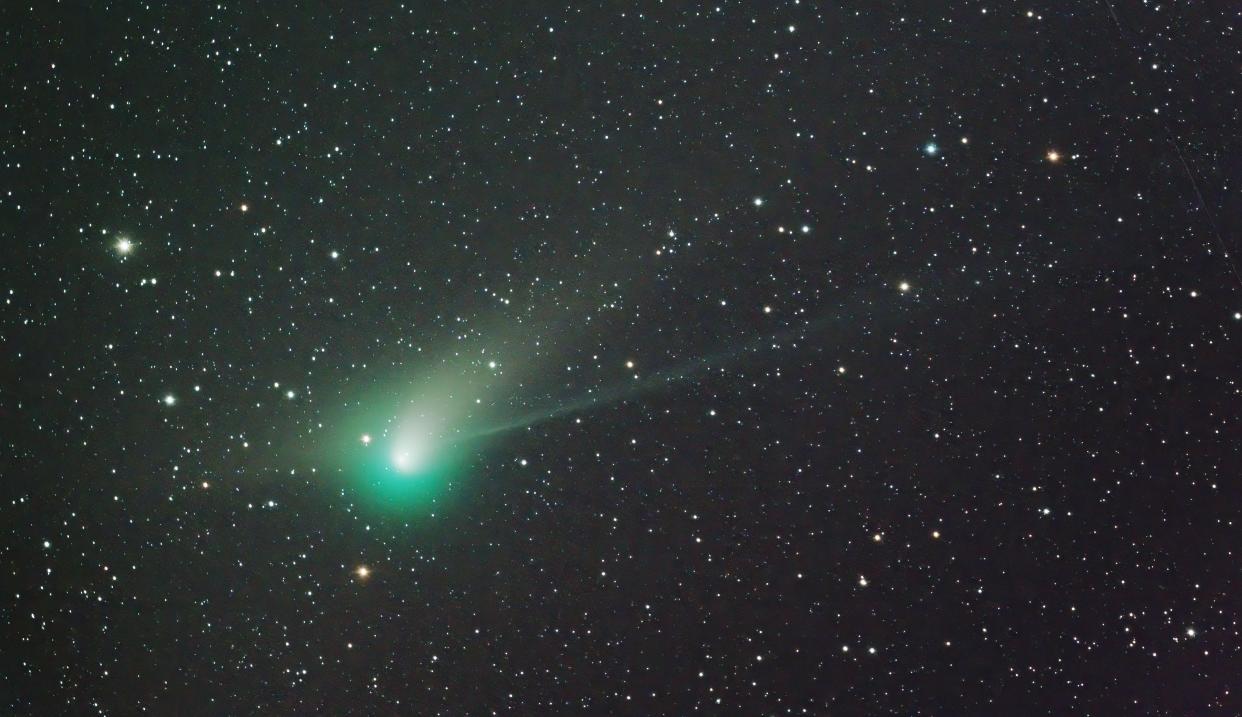Backyard Universe: Visiting comet is a challenge, but here's how to see it from Fayetteville

It happens every few years.
A comet, one of these dirty snowballs made of material left over from the solar system’s formation billions of years ago, becomes bright enough to see in our night skies.
Rarely, maybe once every few decades, a comet reaches a level of brightness that makes it obvious in the sky, and much is made of it, both in the popular press and, in recent years, on social media.
The last time that happened was a couple of years ago when Comet NEOWISE appeared, delighting skywatchers as it with its impressive tail moved each night against the stars.
A recent comet named C/2022 E3(ZTF) is crossing our skies right now, but unless the comet undergoes some type of outburst, there is no chance of it reaching a level that will make it an obvious object in our skies.
The comet’s name is a string of characters that notes its discovery date and the organization that found it. The “C/2022” in the name notes that the object is a comet and was discovered in 2022. The “C” means it is a non-periodic comet that takes more than 200 years to orbit the sun. The “E3” means that it was the third comet discovered in the fifth half month of the year. The (ZTF) designates the comet was discovered by a telescope used by the Zwicky Transient Facility based at Polamar Observatory in California which scans the skies regularly for any moving undiscovered objects in the night sky.
Comets are named for their discoverers. Years ago, that name was usually associated with a person, but many of today’s newly discovered comets are found by automated searches conducted by organizations such as the Zwicky Transient Facility.
The comet is faint for a few reasons. It’s not very large and its orbital geometry is unfavorable for putting on a good show.
It passed closest to the sun Jan. 12, but it still remained farther from the sun than Earth ever gets. The greater the comet’s distance from the sun, generally the fainter it is.
But a close swing by Earth can also make a comet more impressive. Comet C/2022 E3 (ZTF) strikes out there, too. When it passes closest to us Wednesday, it will be no closer than 26 million miles. The comet last appeared some 50,000 years ago and with orbital changes, it may never appear again after the current appearance.
Those of us who want to see this comet will have to do a little detective work, as well as travel to a dark rural location far from city lights. You won’t need a telescope to see it, but a pair of binoculars could make the difference in seeing it or not.
Look north
The comet is currently crossing our northern skies and is well placed in the evening, after spending weeks in the predawn morning sky. A clear sky will be needed to see it.
For the next few evenings, it will appear very near Polaris, the North Star. Polaris can be located by first finding the stars of the Big Dipper which will be standing “bowl up” over in the northeastern sky around 11 p.m. Locate the top “bowl stars” and draw a line through them and extend that line to the left and you’ll come to a medium bright star. That’s Polaris.
On Tuesday around 11 p.m., locate Polaris in your binoculars and then move straight up. The comet will be almost exactly above Polaris on that evening. On Wednesday it lies straight above Polaris at 10 p.m. The following night, Thursday, Comet C/2022 E3 is straight above Polaris at 9 p.m.
In early February the waxing moon will start to brighten the sky so it’s best to try and see the comet before the moon grows too bright, or wait until after the moon sets. Again, a pair of binoculars is key to getting a good view.
Online, Sky and Telescope magazine at skyandtelescope.org has finder charts for the comet at and the website theskylive.com/planetarium has the comet plotted for each night against the stars.
Some phone and tablet apps such as Sky Safari have Comet C/2022E3 (ZWF) in their databases. Those apps are a great way to locate and track the comet each evening.
Remember the comet is faint, even when it’s expected to be at peak brightness in early February. A decent view of it will belong to those folks who make the most effort to see it by traveling to a dark sky site and using a good pair of binoculars.
If you locate it however, you’ll be gazing at an object that hasn’t passed near us for 50,000 years and won’t likely be seen again by anyone on any future dates.
Depending on what new comet discoveries are made this year and how bright any newly discovered comet will become, a view of C/2022 E3(ZTF) may be the brightest comet you can see in 2023.
If you have a question about astronomy, send it to Backyard Universe at johnnyhorne937@gmail.com or P.O. Box 297, Stedman, NC 283912
This article originally appeared on The Fayetteville Observer: Look for Comet C/2022 E3 (ZTF) to pass closest Wednesday

